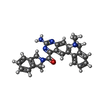[English] 日本語
 Yorodumi
Yorodumi- PDB-6ei5: Estimation of relative drug-target residence times by random acce... -
+ Open data
Open data
- Basic information
Basic information
| Entry | Database: PDB / ID: 6ei5 | ||||||
|---|---|---|---|---|---|---|---|
| Title | Estimation of relative drug-target residence times by random acceleration molecular dynamics simulation | ||||||
 Components Components | Heat shock protein HSP 90-alpha | ||||||
 Keywords Keywords | CHAPERONE / CHAPERONE PROTEIN / ATP BINDING | ||||||
| Function / homology |  Function and homology information Function and homology informationsperm mitochondrial sheath / sulfonylurea receptor binding / dATP binding / CTP binding / positive regulation of protein polymerization / Scavenging by Class F Receptors / vRNP Assembly / UTP binding / chaperone-mediated autophagy / sperm plasma membrane ...sperm mitochondrial sheath / sulfonylurea receptor binding / dATP binding / CTP binding / positive regulation of protein polymerization / Scavenging by Class F Receptors / vRNP Assembly / UTP binding / chaperone-mediated autophagy / sperm plasma membrane / Rho GDP-dissociation inhibitor binding / Respiratory syncytial virus genome replication / telomerase holoenzyme complex assembly / mitochondrial transport / Uptake and function of diphtheria toxin / Drug-mediated inhibition of ERBB2 signaling / Resistance of ERBB2 KD mutants to trastuzumab / Resistance of ERBB2 KD mutants to sapitinib / Resistance of ERBB2 KD mutants to tesevatinib / Resistance of ERBB2 KD mutants to neratinib / Resistance of ERBB2 KD mutants to osimertinib / Resistance of ERBB2 KD mutants to afatinib / Resistance of ERBB2 KD mutants to AEE788 / Resistance of ERBB2 KD mutants to lapatinib / Drug resistance in ERBB2 TMD/JMD mutants / protein import into mitochondrial matrix / dendritic growth cone / TPR domain binding / PIWI-interacting RNA (piRNA) biogenesis / Assembly and release of respiratory syncytial virus (RSV) virions / non-chaperonin molecular chaperone ATPase / protein unfolding / Sema3A PAK dependent Axon repulsion / regulation of protein ubiquitination / positive regulation of cell size / HSF1-dependent transactivation / enzyme-substrate adaptor activity / response to unfolded protein / regulation of protein-containing complex assembly / skeletal muscle contraction / HSF1 activation / Attenuation phase / neurofibrillary tangle assembly / chaperone-mediated protein complex assembly / RHOBTB2 GTPase cycle / regulation of postsynaptic membrane neurotransmitter receptor levels / telomere maintenance via telomerase / axonal growth cone / positive regulation of lamellipodium assembly / nitric oxide metabolic process / eNOS activation / DNA polymerase binding / response to salt stress / positive regulation of defense response to virus by host / Tetrahydrobiopterin (BH4) synthesis, recycling, salvage and regulation / positive regulation of telomere maintenance via telomerase / Signaling by ERBB2 / cardiac muscle cell apoptotic process / endocytic vesicle lumen / positive regulation of cardiac muscle contraction / Loss of Nlp from mitotic centrosomes / Loss of proteins required for interphase microtubule organization from the centrosome / Recruitment of mitotic centrosome proteins and complexes / lysosomal lumen / Recruitment of NuMA to mitotic centrosomes / activation of innate immune response / Anchoring of the basal body to the plasma membrane / ESR-mediated signaling / positive regulation of interferon-beta production / HSP90 chaperone cycle for steroid hormone receptors (SHR) in the presence of ligand / protein tyrosine kinase binding / response to cold / Constitutive Signaling by Overexpressed ERBB2 / AURKA Activation by TPX2 / nitric-oxide synthase regulator activity / VEGFR2 mediated vascular permeability / response to cocaine / ATP-dependent protein folding chaperone / brush border membrane / Signaling by ERBB2 TMD/JMD mutants / Constitutive Signaling by EGFRvIII / Signaling by ERBB2 ECD mutants / Signaling by ERBB2 KD Mutants / DDX58/IFIH1-mediated induction of interferon-alpha/beta / cellular response to virus / Regulation of actin dynamics for phagocytic cup formation / positive regulation of protein import into nucleus / Regulation of necroptotic cell death / VEGFA-VEGFR2 Pathway / response to estrogen / tau protein binding / histone deacetylase binding / Downregulation of ERBB2 signaling / neuron migration / Chaperone Mediated Autophagy / disordered domain specific binding / positive regulation of nitric oxide biosynthetic process / Aggrephagy / MHC class II protein complex binding / positive regulation of protein catabolic process Similarity search - Function | ||||||
| Biological species |  Homo sapiens (human) Homo sapiens (human) | ||||||
| Method |  X-RAY DIFFRACTION / X-RAY DIFFRACTION /  SYNCHROTRON / SYNCHROTRON /  MOLECULAR REPLACEMENT / MOLECULAR REPLACEMENT /  molecular replacement / Resolution: 2.2 Å molecular replacement / Resolution: 2.2 Å | ||||||
 Authors Authors | Musil, D. / Lehmann, M. / Eggenweiler, H.-M. | ||||||
 Citation Citation |  Journal: J Chem Theory Comput / Year: 2018 Journal: J Chem Theory Comput / Year: 2018Title: Estimation of Drug-Target Residence Times by tau-Random Acceleration Molecular Dynamics Simulations. Authors: Kokh, D.B. / Amaral, M. / Bomke, J. / Gradler, U. / Musil, D. / Buchstaller, H.P. / Dreyer, M.K. / Frech, M. / Lowinski, M. / Vallee, F. / Bianciotto, M. / Rak, A. / Wade, R.C. | ||||||
| History |
|
- Structure visualization
Structure visualization
| Structure viewer | Molecule:  Molmil Molmil Jmol/JSmol Jmol/JSmol |
|---|
- Downloads & links
Downloads & links
- Download
Download
| PDBx/mmCIF format |  6ei5.cif.gz 6ei5.cif.gz | 100.1 KB | Display |  PDBx/mmCIF format PDBx/mmCIF format |
|---|---|---|---|---|
| PDB format |  pdb6ei5.ent.gz pdb6ei5.ent.gz | 76.6 KB | Display |  PDB format PDB format |
| PDBx/mmJSON format |  6ei5.json.gz 6ei5.json.gz | Tree view |  PDBx/mmJSON format PDBx/mmJSON format | |
| Others |  Other downloads Other downloads |
-Validation report
| Summary document |  6ei5_validation.pdf.gz 6ei5_validation.pdf.gz | 813.5 KB | Display |  wwPDB validaton report wwPDB validaton report |
|---|---|---|---|---|
| Full document |  6ei5_full_validation.pdf.gz 6ei5_full_validation.pdf.gz | 815.3 KB | Display | |
| Data in XML |  6ei5_validation.xml.gz 6ei5_validation.xml.gz | 10.4 KB | Display | |
| Data in CIF |  6ei5_validation.cif.gz 6ei5_validation.cif.gz | 13.3 KB | Display | |
| Arichive directory |  https://data.pdbj.org/pub/pdb/validation_reports/ei/6ei5 https://data.pdbj.org/pub/pdb/validation_reports/ei/6ei5 ftp://data.pdbj.org/pub/pdb/validation_reports/ei/6ei5 ftp://data.pdbj.org/pub/pdb/validation_reports/ei/6ei5 | HTTPS FTP |
-Related structure data
| Related structure data |  5lo5C  5lo6C  6el5C  6elnC  6eloC  6elpC  6ey8C 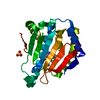 6ey9C 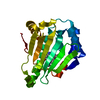 6eyaC 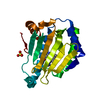 6eybC 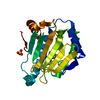 6f1nC C: citing same article ( |
|---|---|
| Similar structure data |
- Links
Links
- Assembly
Assembly
| Deposited unit | 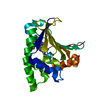
| ||||||||
|---|---|---|---|---|---|---|---|---|---|
| 1 |
| ||||||||
| Unit cell |
|
- Components
Components
| #1: Protein | Mass: 23392.451 Da / Num. of mol.: 1 Source method: isolated from a genetically manipulated source Source: (gene. exp.)  Homo sapiens (human) / Gene: HSP90AA1, HSP90A, HSPC1, HSPCA / Production host: Homo sapiens (human) / Gene: HSP90AA1, HSP90A, HSPC1, HSPCA / Production host:  |
|---|---|
| #2: Chemical | ChemComp-B5Q / [ |
| #3: Water | ChemComp-HOH / |
-Experimental details
-Experiment
| Experiment | Method:  X-RAY DIFFRACTION / Number of used crystals: 1 X-RAY DIFFRACTION / Number of used crystals: 1 |
|---|
- Sample preparation
Sample preparation
| Crystal | Density Matthews: 3.24 Å3/Da / Density % sol: 62.02 % |
|---|---|
| Crystal grow | Temperature: 277 K / Method: vapor diffusion, hanging drop Details: Na-Cacodylate, pH 6.5 30% PEG8000 0.2 M ammonium sulfate |
-Data collection
| Diffraction | Mean temperature: 100 K |
|---|---|
| Diffraction source | Source:  SYNCHROTRON / Site: SYNCHROTRON / Site:  SLS SLS  / Beamline: X06SA / Wavelength: 1 Å / Beamline: X06SA / Wavelength: 1 Å |
| Detector | Type: DECTRIS PILATUS 6M / Detector: PIXEL / Date: Jul 21, 2007 |
| Radiation | Protocol: SINGLE WAVELENGTH / Monochromatic (M) / Laue (L): M / Scattering type: x-ray |
| Radiation wavelength | Wavelength: 1 Å / Relative weight: 1 |
| Reflection | Resolution: 2.2→49.49 Å / Num. obs: 15749 / % possible obs: 99.6 % / Redundancy: 6.6 % / Biso Wilson estimate: 65.35 Å2 / Net I/σ(I): 22.5 |
-Phasing
| Phasing | Method:  molecular replacement molecular replacement |
|---|
- Processing
Processing
| Software |
| ||||||||||||||||||||||||||||||||||||||||
|---|---|---|---|---|---|---|---|---|---|---|---|---|---|---|---|---|---|---|---|---|---|---|---|---|---|---|---|---|---|---|---|---|---|---|---|---|---|---|---|---|---|
| Refinement | Method to determine structure:  MOLECULAR REPLACEMENT / Resolution: 2.2→49.49 Å / Cor.coef. Fo:Fc: 0.957 / Cor.coef. Fo:Fc free: 0.954 / SU R Cruickshank DPI: 0.183 / Cross valid method: THROUGHOUT / σ(F): 0 / SU R Blow DPI: 0.182 / SU Rfree Blow DPI: 0.156 / SU Rfree Cruickshank DPI: 0.158 MOLECULAR REPLACEMENT / Resolution: 2.2→49.49 Å / Cor.coef. Fo:Fc: 0.957 / Cor.coef. Fo:Fc free: 0.954 / SU R Cruickshank DPI: 0.183 / Cross valid method: THROUGHOUT / σ(F): 0 / SU R Blow DPI: 0.182 / SU Rfree Blow DPI: 0.156 / SU Rfree Cruickshank DPI: 0.158
| ||||||||||||||||||||||||||||||||||||||||
| Displacement parameters | Biso max: 195.73 Å2 / Biso mean: 89.9 Å2 / Biso min: 51.86 Å2
| ||||||||||||||||||||||||||||||||||||||||
| Refine analyze | Luzzati coordinate error obs: 0.31 Å | ||||||||||||||||||||||||||||||||||||||||
| Refinement step | Cycle: final / Resolution: 2.2→49.49 Å
| ||||||||||||||||||||||||||||||||||||||||
| LS refinement shell | Resolution: 2.2→2.35 Å / Rfactor Rfree error: 0 / Total num. of bins used: 8
| ||||||||||||||||||||||||||||||||||||||||
| Refinement TLS params. | Method: refined / Origin x: -33.4606 Å / Origin y: -15.2107 Å / Origin z: -20.7411 Å
| ||||||||||||||||||||||||||||||||||||||||
| Refinement TLS group | Selection details: { A|* } |
 Movie
Movie Controller
Controller



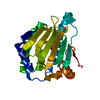
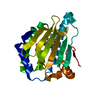

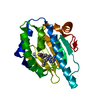
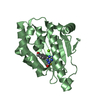
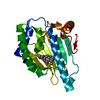
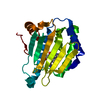
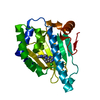



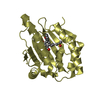
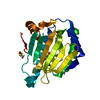
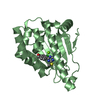
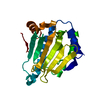
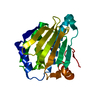
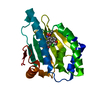

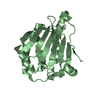
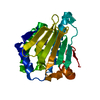
 PDBj
PDBj



















